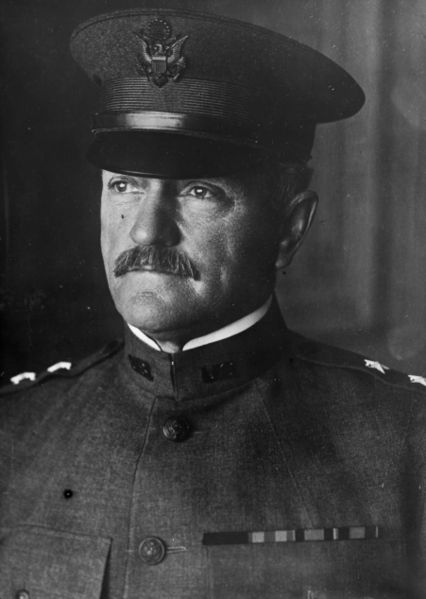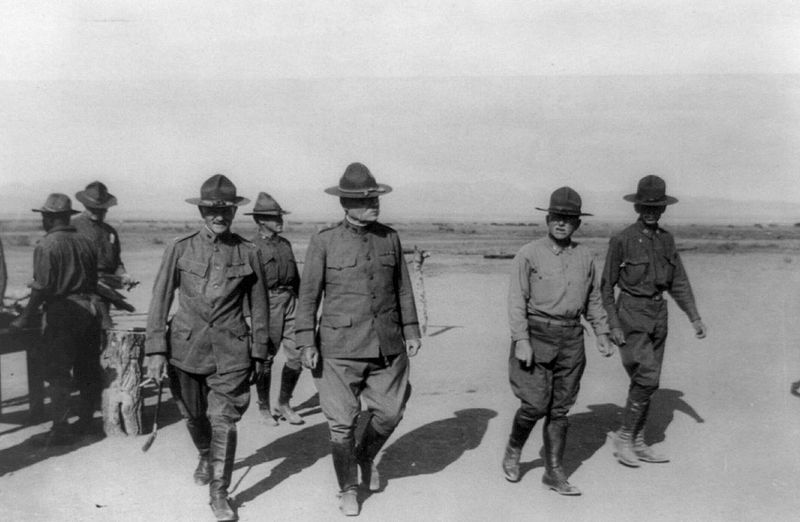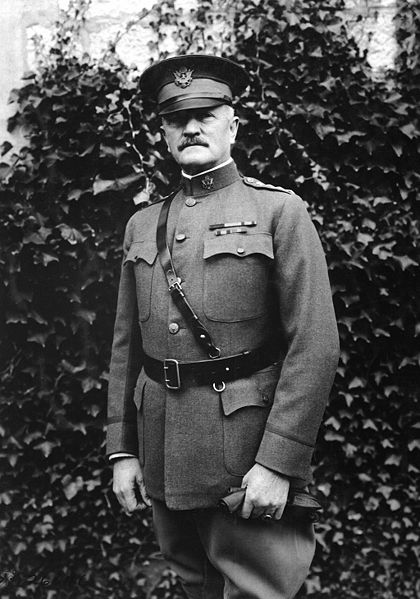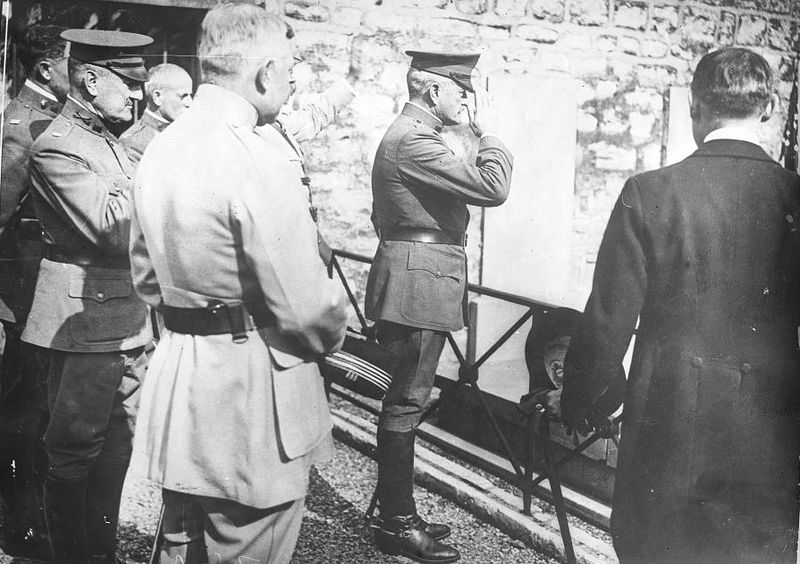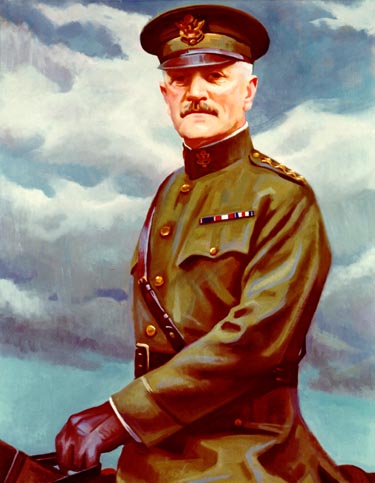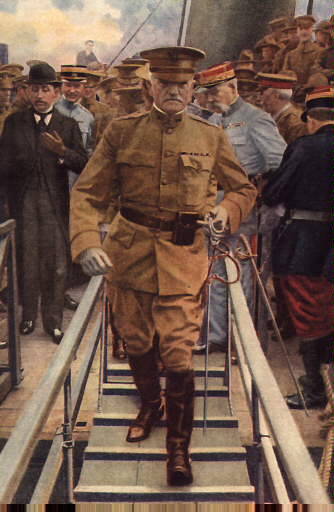<Back to Index>
- Psychiatrist Adolf Meyer, 1866
- Composer Arnold Schoenberg, 1874
- United States General of the Armies John Joseph "Black Jack" Pershing, 1860
PAGE SPONSOR
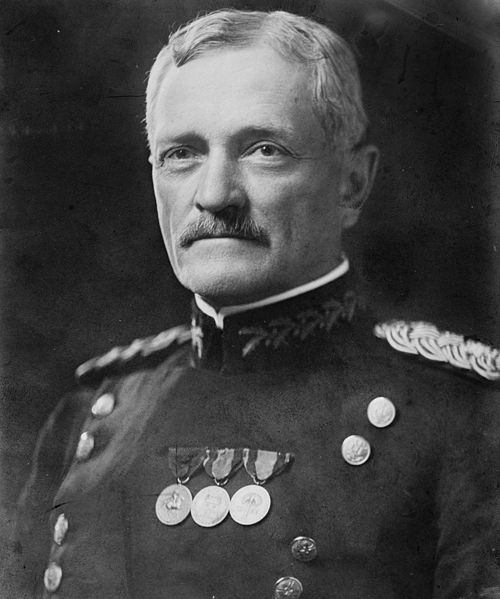
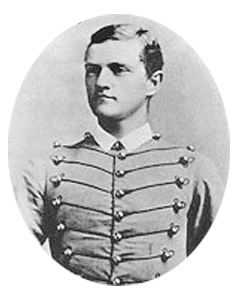

John Joseph "Black Jack" Pershing, GCB (Hon) (September 13, 1860 – July 15, 1948) was a general officer in the United States Army. Pershing is the only person to be promoted in his own lifetime to the highest rank ever held in the United States Army — General of the Armies (a retroactive Congressional edict passed in 1976 promoted George Washington to the same rank but with higher seniority). Pershing also holds the first United States officer service number (O-1). Pershing led the American Expeditionary Forces in World War I, and was regarded as a mentor by the generation of American generals who led the United States Army in Europe during World War II, including George C. Marshall, Dwight D. Eisenhower, Omar N. Bradley, and George S. Patton.
John Joseph Pershing was born on a farm near Laclede, Missouri, to businessman John Fletcher Pershing and homemaker Ann Elizabeth Thompson. He also had five siblings: sisters Ann Elizabeth, Margaret, and May; brothers Ward and James. When the Civil War began, John F. Pershing worked as a sutler for the 18th Missouri Volunteer Infantry, but he did not serve in the military. John J. Pershing attended a school in Laclede that was reserved for precocious students who were also the children of prominent citizens. Completing high school in 1878, he became a teacher of local African American children.
In 1880, Pershing entered the North Missouri Normal School (now Truman State University) in Kirksville, Missouri. Two years later, he applied to the United States Military Academy.
Pershing later admitted that serving in the military was secondary to
attending West Point, and he had applied because the education offered
was better than that obtainable in rural Missouri. Pershing
was sworn in as a West Point cadet in the fall of 1882. He was selected
early for leadership and became successively First Corporal, First
Sergeant, First Lieutenant, and First Captain, the highest possible
cadet rank. Pershing commanded ex officio the West Point Honor Guard that escorted the funeral of President Ulysses S. Grant. Pershing graduated from West Point in the summer of 1886 and was commended by the Superintendent of West Point, General Wesley Merritt, for high leadership skills and possessing "superb ability." Pershing
briefly considered petitioning the Army to let him study law and delay
his commission. He applied for a furlough from West Point, but soon
withdrew the request in favor of active Army duty. He was commissioned a Second Lieutenant in the United States Army in 1886, at age twenty-six, graduating 30th in a class of 77. Pershing reported for active duty on September 30, 1886, and was assigned to Troop L of the 6th U.S. Cavalry stationed at Fort Bayard, in the New Mexico Territory. While serving in the 6th Cavalry, Pershing participated in several Indian campaigns and was cited for bravery for actions against the Apache. During his time at Fort Stanton, Pershing and close friends Lt. Julius Penn and Lt.Richard B. Paddock were
nicknamed "The Three Green P's," spending their leisure time hunting
and attending Hispanic dances. Pershing's sister Grace married Paddock
in 1890. Between 1887 and 1890, Pershing served with the 6th Cavalry at various postings in California, Arizona, and North Dakota.
He also became an expert marksman and, in 1891, was rated second in
pistol and fifth in rifle out of all soldiers in the U.S. Army. On December 9, 1890, Pershing and the 6th Cavalry arrived at Sioux City, Iowa, where Pershing played a role in suppressing the last uprisings of the Lakota (Sioux) Indians. He participated as a 2nd Lieutenant in the Wounded Knee Massacre. A year later, he was assigned as an instructor of military tactics at the University of Nebraska-Lincoln.
Pershing held this post until 1895. While in Nebraska, Pershing
attended law school and graduated in 1893. Additionally, he formed a
drill company, Company A, in 1891 that won the Omaha Cup.
In 1893, Company A became a fraternal organization and changed its name
to the Varsity Rifles. The group changed its name for the last time in
1894, renaming itself the Pershing Rifles in honor of its founder. On October 1, 1895, Pershing was promoted to first lieutenant and took command of a troop of the 10th Cavalry Regiment (one of the original Buffalo Soldier regiments), composed of African-American soldiers under white officers. From Fort Assinniboine in north central Montana, he commanded an expedition to the south and southwest that rounded up and deported a large number of Cree Indians to Canada.
In
1897, Pershing was appointed to the West Point tactical staff as an
instructor, where he was assigned to Cadet Company A. Because of his
strictness and rigidity, Pershing was unpopular with the cadets, who
took to calling him "Nigger Jack" because of his service with the 10th Cavalry. During the course of his tour at the Academy, this epithet softened to "Black Jack", although, according to Vandiver, "the intent remained hostile." Still, this nickname would stick with Pershing for the rest of his life, and was known to the public as early as 1917. At the start of the Spanish-American War, First Lieutenant Pershing was offered a brevet rank and commissioned a major of volunteers on August 26, 1898. He fought with the 10th Cavalry (Buffalo Soldiers) on Kettle and San Juan Hill in Cuba and was cited for gallantry. (In 1919, he was awarded the Silver Citation Star for these actions, and in 1932 the award was upgraded to the Silver Star Medal.) In March 1899, after suffering from malaria,
Pershing was put in charge of the Office of Customs and Insular Affairs
which oversaw occupation forces in territories gained in the
Spanish-American War, including Cuba, Puerto Rico, the Philippines, and Guam. When the Philippine-American War began, Pershing was ordered to Manila. He reported on August 17, 1899 as a Brevet Major of Volunteers and was assigned to the Department of Mindanao and Jolo and
commanded efforts to suppress the Philippine insurrection. On November
27, 1900, Pershing was appointed Adjutant General of his department and
served in this posting until March 1, 1901. He was cited for bravery
for actions on the Cagayan River while attempting to destroy a Philippine stronghold at Macajambo. In 1901, Pershing's brevet commission was revoked, and he reassumed his rank as captain in the Regular Army. He served with the 1st Cavalry Regiment in the Philippines. He later was assigned to the 15th Cavalry Regiment, serving as an intelligence officer and participating in actions against the Moros. He was cited for bravery at Lake Lanao.
In June 1901, he served as Commander of Camp Vicars in Lanao,
Philippines, after the previous camp commander had been promoted to brigadier general.
In June 1903, Pershing was ordered to return to the United States. President Theodore Roosevelt, taken by Pershing's ability, petitioned the Army General Staff to promote Pershing to colonel. At the time, Army officer promotions were based primarily on seniority, rather than merit, and
although there was widespread acknowledgment that Pershing should serve
as a colonel, the Army General Staff declined to change their
seniority-based promotion tradition just to accommodate Pershing. They
would not consider a promotion to lieutenant colonel or even major.
This angered Roosevelt, but since the President could only name and
promote army officers in the General ranks, his options for recognizing
Pershing through promotion were limited. In 1904, Pershing was assigned as the Assistant Chief of Staff of the Southwest Army Division stationed at Oklahoma City, Oklahoma. In October 1904, he attended the Army War College, and then was ordered to Washington, D.C. for "general duties unassigned." Since Theodore Roosevelt could not yet promote Pershing, he petitioned the United States Congress to authorize a diplomatic posting, and Pershing was stationed as military attaché in Tokyo in 1905. Also in 1905, Pershing married Helen Frances Warren, the daughter of powerful U.S. Senator Francis E. Warren, a Wyoming Republican and chairman of the U.S. Military Appropriations Committee. Some have indicated this union helped his military career. After serving as an observer in the Russo-Japanese War, Pershing returned to the United States in the fall of 1905. In a move that shocked the army establishment, President Roosevelt employed his presidential prerogative and nominated Pershing as a brigadier general, a move which Congress approved. In skipping three ranks and more than
835 officers senior to him, the promotion outraged ranking Army officers who
would state, for the rest of their careers, that Pershing's appointment
was the result of political connections and not military abilities. However,
many other officers supported Pershing and believed that, based on his
demonstrated ability to command combat forces, the promotion to
general, while unusual, was not out of line. In 1908, Pershing briefly served as a U.S. military observer in the Balkans, an assignment which was based out of Paris.
Upon returning to the United States at the end of 1909, Pershing was
assigned once again to the Philippines, an assignment which he served
until 1912. While in the Philippines, he served as Commander of Fort
McKinley, near Manila, and also was the governor of the Moro Province.
The last of Pershing's four children was born in the Philippines, and
during this time he became an Episcopalian. In January 1914, Pershing was assigned to command the Army 8th Cavalry Regiment in Fort Bliss, Texas, responsible for security along the U.S.-Mexico border. In March 1916, under the command of General Frederick Funston, Pershing led the 8th Regiment on the failed 1916–17 Punitive Expedition into Mexico in search of the revolutionary leader Pancho Villa. He had met him in 1913 when he invited him to Fort Bliss. During this time,George S. Patton served as one of Pershing's aides. After
a year at Fort Bliss, Pershing decided to take his family there. The
arrangements were almost complete, when on the morning of August 27,
1915, he received a telegram telling him of a tragic fire in the Presidio of San Francisco,
where a lacquered floor blaze had rapidly spread, resulting in the
smoke inhalation deaths of his wife, Helen, and three young daughters.
Only his six-year-old son Warren was saved. Many who knew Pershing said
he never recovered from their deaths. After the funerals at Lakeview
Cemetery in Cheyenne, Wyoming, Pershing returned to Fort Bliss with his son, Warren, and his sister Mae, and resumed his duties as commanding officer. At the start of the United States' involvement in World War I President Woodrow Wilson considered mobilizing an army to join the fight. Frederick Funston,
Pershing's superior in Mexico, was being considered for the top billet
as the Commander of the American Expeditionary Force (AEF) when he died
suddenly from a heart attack on February 19, 1917. Following America's
entrance into the war, Wilson, after a short interview, named Pershing
to command, a post which he retained until 1918. Pershing, who was a major general, was promoted to full general (the first since Philip Sheridan in 1888) in the National Army,
and was made responsible for the organization, training, and supply of
a combined professional and draft Army and National Guard force that
eventually grew from 27,000 inexperienced men to two Armies (a third
was forming as the war ended) totaling over two million soldiers. Pershing exercised significant control over his command, with a full delegation of authority from Wilson and Secretary of War Newton D. Baker. Baker, cognizant of the endless problems of domestic and allied
political involvement in military decision making in wartime, gave
Pershing unmatched authority to run his command as he saw fit. In turn,
Pershing exercised his prerogative carefully, not engaging in issues
that might distract or diminish his command. While earlier a champion
of the African-American soldier, he did not champion their full
participation on the battlefield, understanding widespread racial
attitudes among white Americans generally, plus Wilson's reactionary
views on race and the political debts he owed to southern Democratic
law makers. George C. Marshall served as one of Pershing's top assistants during and after the war. Pershing's initial chief of staff was businessman James Harbord,
who later took a combat command but worked as Pershing's closest
assistant for many years and remained extremely loyal to Pershing.
After departing from Fort Jay at Governors Island in
New York Harbor under top secrecy in May 1917, Pershing arrived in
France in June 1917. In a show of American presence, part of the 16th
Infantry Regiment marched through Paris shortly after his arrival.
Pausing at Gilbert du Motier, marquis de La Fayette's
tomb, he was reputed to have uttered the famous line "Lafayette, we are
here." The line was in fact spoken by his aide, Colonel Charles E. Stanton. American forces were deployed in France in the autumn of 1917. For the first time in American history, Pershing allowed American soldiers
to be under the command of a foreign power. In late June, General
Rawlinson commanding the British Fourth Army suggested to Australian
Lieutenant General John Monash that American involvement in a set-piece
attack alongside the experienced Australians in the upcoming Battle of Hamel would
both give the American troops experience and also strengthen the
Australian battalions by an additional company each. On June 29,
General Bell, commanding the American 33rd Division, selected two
companies each from the 131st and 132nd Infantry regiments of the 66th
brigade. However, Monash had been promised ten companies of American
troops and on June 30 the remaining companies of the 1st and 2nd
battalions of the 131st regiment were sent. Each American platoon was
attached to an Australian company. However, there was difficulty in
integrating the American platoons (which numbered 60 men) amongst the
Australian companies of 100 men. This difficulty was overcome by
reducing the size of each American platoon by one-fifth and sending
these troops, which numbered 50 officers and men, back to battalion
reinforcement camps.
Pershing
bowed to the racial policies of President Woodrow Wilson, Secretary of
War Newton D. Baker, and southern Democrats who promoted the " separate
but equal"
doctrine. African-American "Buffalo Soldiers" units were not allowed to
participate with the American Expeditionary Force (AEF) during World
War I, but experienced non-commissioned officers were provided to other
segregated black units for combat service — such as the 317th Engineer
Battalion. The American Buffalo Soldiers of the 92nd Infantry Division
(United States) and the 93rd Infantry Division (United States) were
the first Americans to fight in France in 1918, albeit detached from
the AEF and under French command. Most regiments of the 92nd and all of
the 93rd would continue to fight under French command for the duration
of the war. In
early 1918, entire divisions were beginning to serve on the front lines
alongside French troops. Pershing insisted that the AEF fight as units
under American command rather than being split up by battalions to
augment British and French regiments and brigades (although the U.S. 27th and 30th Divisions, loaned during the desperate days of spring 1918, fought with the British/Australian/Canadian Fourth Army until the end of the war, taking part in the breach of the Hindenburg Line in October).
In October 1918, Pershing saw the need for a dedicated Military Police Corps and the first US Army MP School was established at Autun, France. For this, he is considered the "founding father" of the MPs. Because of the effects of trench warfare on soldiers' feet, in January, 1918, Pershing oversaw the creation of an improved combat boot, the "1918 Trench Boot," which became known as the "Pershing Boot" upon its introduction. American
forces first saw serious action during the summer of 1918, contributing
eight large divisions, alongside 24 French ones, at the Second Battle of the Marne. Along with the British Fourth Army's victory at Amiens, the Franco-American victory at the Second Battle of the Marne marked the turning point of the war on the Western Front. In August 1918 the U.S. First Army had been formed, first under Pershing's direct command and then by Hunter Liggett, when the U.S. Second Army under Robert Bullard was created. After a quick victory at Saint-Mihiel, east of Verdun, some of the more bullish AEF commanders had hoped to push on eastwards to Metz, but this did not fit in with the plans of the Allied Supreme Commander, Marshal Foch,
for three simultaneous offensives into the "bulge" of the Western Front
(the other two being the Fourth Army's breach of the Hindenburg Line
and an Anglo-Belgian offensive, led by Plumer's Second
Army, in Flanders). Instead, the AEF was required to redeploy and,
aided by French tanks, launched a major offensive northwards in very
difficult terrain at Meuse-Argonne.
Initially enjoying numerical odds of eight to one, this offensive
eventually engaged 35 or 40 of the 190 or so German divisions on the
Western Front, although to put this in perspective, around half the
German divisions were engaged on the British Expeditionary Force (BEF) sector at the time. When he arrived in Europe, Pershing had openly scorned the slow trench warfare of
the previous three years on the Western Front, believing that American
soldiers' skill with the rifle would enable them to avoid costly and
senseless fighting over a small area of no man's land.
This was regarded as unrealistic by British and French generals, and
(privately) by a number of American generals such as Army Chief of Staff Tasker H. Bliss and
his own Hunter Liggett. The AEF had done well in the relatively open
warfare of the Second Battle of the Marne, but the eventual U.S.
casualty rates against German defensive positions in the Argonne
(120,000 U.S. casualties in six weeks, against 35 or 40 German
divisions) were not noticeably better than those of the Franco-British
offensive on the Somme two years earlier (600,000 casualties in four and a half months, versus 50
or so German divisions). More ground was gained, but then the German
Army was in worse shape than in previous years. Some writers have
speculated that Pershing's frustration at the slow progress through the
Argonne was the cause of two incidents which then ensued. First, he
ordered the U.S. First Army to take "the honor" of recapturing Sedan, site of the French defeat in 1870;
the ensuing confusion (an order was issued that "boundaries were not to
be considered binding") exposed U.S. troops to danger not only from the
French on their left, but even from one another, as the 1st Division tacked westward by night across the path of the 42nd (accounts
differ as to whether Douglas MacArthur was really mistaken for a German
officer and arrested). Liggett, who had been away from headquarters the
previous day, had to sort out the mess and implement the instructions
from Supreme Commander Marshal Foch, allowing the French to recapture
the city; he later recorded that this was the only time during the war
in which he lost his temper. Second, Pershing sent an unsolicited letter to the Allied Supreme War Council,
demanding that the Germans not be given an armistice and that instead,
the Allies should push on and obtain an unconditional surrender. Although in later years, many, including President Franklin D. Roosevelt,
felt that Pershing had had a point, at the time, this was a breach of
political authority. Pershing narrowly escaped a serious reprimand from
Wilson's aide, Colonel House, and later apologized. At the time of the Armistice, another U.S.-French offensive was due to start on November 14, thrusting towards Metz and into Lorraine, to take place simultaneously with further BEF advances through Belgium. In
his memoirs, Pershing claimed that the U.S. breakout from the Argonne
at the start of November was the decisive event leading to the German acceptance
of an armistice, because it made untenable the Antwerp-Meuse line. This
is probably an exaggeration; the outbreak of civil unrest and naval
mutiny in Germany, the collapse of Bulgaria, Turkey, and particularly Austria-Hungary following Allied victories in Salonika,
Syria, and Italy, and the Allied victories on the Western Front were
among a series of events in the autumn of 1918 which made it clear that
Allied victory was inevitable, and diplomatic inquiries about an
armistice had been going on throughout October. President Wilson was
keen to tie matters up before the mid-term elections, and
the other Allies did not have the strength to defeat Germany without
U.S. help, so had little choice but to follow Wilson's lead.
American successes were largely credited to Pershing, and he became the most celebrated American leader of the war. Critics, however, claimed that Pershing commanded from far behind the lines and was
critical of commanders who personally led troops into battle. Douglas MacArthur saw
Pershing as a desk soldier, and the relationship between the two men
deteriorated by the end of the war. Similar criticism of senior
commanders by the younger generation of officers (the future generals of World War II)
was made in the British and other armies, but in fairness to Pershing,
although it was not uncommon for brigade commanders to serve near the
front and even be killed, the state of communications in World War I
made it more practical for senior generals to command from the rear. He
controversially ordered his troops to continue fighting after the
armistice was signed. This resulted in 3,500 U.S. casualties on the
last day of the war, an act which was regarded as murder by several
officers under his command.
In 1919, in recognition of his distinguished service during World War I, the U.S. Congress authorized the President to promote Pershing to General of the Armies of the United States,
the highest rank possible for any member of the United States armed
forces, which was created especially for him and one that only he held
at the time (General George Washington was posthumously promoted to this rank by President Gerald Ford in
1976). Pershing was authorized to create his insignia for the new rank
and chose to wear four gold stars for the rest of his career, which
separated him from the four (temporary) silver stars worn by Army
Chiefs of Staff, and even the five star General of the Army insignia worn by Marshall, MacArthur, Bradley, Eisenhower, and H. 'Hap' Arnold in World War II (Pershing outranked them all). There was a movement to make Pershing President of the United States in
1920, but he refused to actively campaign. In a newspaper article, he
said that he "wouldn't decline to serve" if the people wanted him, and
this made front page headlines. Though Pershing was a Republican, many
of his party's leaders considered him too closely tied to the policies
of the Democratic Party's President Wilson. The Republican nomination went to Senator Warren G. Harding of Ohio, who won the 1920 presidential election. In 1921, Pershing became Chief of Staff of the United States Army, serving for three years. He created the Pershing Map, a proposed national network of military and civilian highways. The Interstate Highway System instituted
in 1956 bears considerable resemblance to the Pershing map. In 1924,
then 64 years old, Pershing retired from active military service, yet
continued to be listed on the active duty rolls as part of his
commission as General of the Armies. On November 1, 1921, Pershing was in Kansas City to take part in the groundbreaking ceremony for the Liberty Memorial that was being constructed there. Also present that day were Lieutenant General Baron Jacques of Belgium, Admiral David Beatty of Great Britain, Marshal Ferdinand Foch of France and General Armando Diaz of Italy. One of the main speakers was Vice President Calvin Coolidge. In 1935, bas-reliefs of Pershing, Jacques, Foch and Diaz by sculptor Walker Hancock were added to the memorial. On
October 2, 1922, amidst several hundred officers, many of them combat
veterans of World War I, Pershing formally established the Reserve Officers Association (ROA)
as an organization at the Willard Hotel in Washington, D.C. ROA is a
75,000-member, professional association of officers, former officers,
and spouses of all the uniformed services of the United States,
primarily the Reserve and United States National Guard. It is a
congressionally chartered Association that advises the Congress and the
President on issues of national security on behalf of all members of
the Reserve Component. During the 1930s, Pershing maintained a private life but was made famous by his memoirs, My Experiences in the World War, which were awarded the 1932 Pulitzer Prize for history. He was also an active Civitan during this time. In 1940, Pershing was an outspoken advocate of aid for the United Kingdom during World War II. In 1944, with the creation of the new five star rank General of the Army,
Pershing was acknowledged as the highest ranking officer of the United
States military. When asked if this made Pershing a six star General, Secretary of War Henry L. Stimson commented
that it did not, since Pershing never wore more than four stars but
that Pershing was still to be considered senior to the present five
star generals of World War II. In July 1944, Pershing was visited by Free French leader General Charles de Gaulle. When Pershing, by then semi-senile, asked after the health of his old friend, Marshal Philippe Pétain (who was heading the pro-German Vichy regime), de Gaulle replied tactfully that when he last saw him, the Marshal was well.
On July 15, 1948, Pershing died of coronary artery disease and congestive heart failure at the Walter Reed Army Medical Center in Washington, D.C., which was his home after 1944. He was buried in Arlington National Cemetery, near the grave sites of the soldiers he commanded in Europe, after a state funeral. It was during his initial assignment in the American West that his mother died. On March 16, 1906, Pershing's father died. Colonel Francis Warren Pershing (1909 – 1980), John J. Pershing's son, served in the Second World War as an advisor to the Army Chief of Staff, General George C. Marshall.
After the War he continued with his financial career and founded a
stock brokerage firm (Pershing & Company). He was father to two
sons, Richard W. Pershing (1942 – 1968) and John Warren Pershing III
(1941 – 1999). Richard Pershing served as a 2nd Lieutenant (O1) in the 502nd Infantry and was killed in action on February 17, 1968, in Vietnam. John Pershing III served as a special assistant to former Army Chief of Staff General Gordon R. Sullivan, also attaining the rank of Colonel (O6). He helped shape Army and Army ROTC programs nationwide. Col. Pershing died of cardiovascular disease in 1999.
